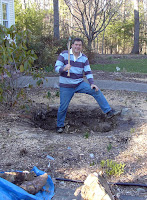Somewhere between the shoots and the second mounding, the Colorado Potato Beetle News Network apparently offered a too-good-to-turn-down feed’n’breed excursion fare to Medfield. Though there were no other plots with potatoes in them, I arrived one morning to find my two rows infested with the nasty little things. (The alternative explanation is parthenogenesis and I don’t want to go there.)
For the next three months, I picked potato beetles and smooshed potato beetle egg masses. I stopped by the garden twice each day to get both the early risers and the evening adventurers. Still, they arrived in quantities that defied all logic because I would find dozens of bugs each visit. Finally, in mid-September I dug up the two rows and bagged the resulting production. I figured I had about twenty pounds of spuds.
That very weekend, a Roche Brothers flyer arrived announcing Prince Edward Island potatoes at 99 cents for a ten-pound bag.
I felt compelled to compute the value of my labor. Even excluding travel time (I always weeded other vegetables while at the garden), I spent a minimum of twenty minutes a day on potato beetle duty. I did this for, say, sixty days. That’s 1200 minutes or twenty hours. All to get $1.98 worth of potatoes.
Generously rounded up, that’s ten cents an hour for my labor. And I lied. There were times when there was nothing else to do in the garden except pick beetles.
I have not grown potatoes since.
 I have, however, removed a stump. Three years ago, a 60-foot-high, five-stem clump birch was cut down because it was a) considerably taller that our home and b) dangerously close to our septic system. Cutting it down was the easy part. We did it in February and were left with a two-foot high stump. I proposed putting a sundial on it. The idea went nowhere.
I have, however, removed a stump. Three years ago, a 60-foot-high, five-stem clump birch was cut down because it was a) considerably taller that our home and b) dangerously close to our septic system. Cutting it down was the easy part. We did it in February and were left with a two-foot high stump. I proposed putting a sundial on it. The idea went nowhere.We then went looking for someone to either grind out or pull out the stump. Our problem was that the birch was in the middle of a perennial bed with other shrubs in very close proximity. Everyone with whom we spoke said that the stump grinder would have to sit in the bed, destroying perennials that would begin emerging in March. A backhoe would be even more disastrous.
What was the value per hour of labor? It’s impossible to say. Because no contractor could meet our requirements, we never got as far as asking for a price. We also got exactly what we wanted in terms of results. Like the MasterCard says, some things are priceless. Above is a photo of the bed taken today (April 23).
Not so my current project. Last autumn, we had a pair of Norway maples removed from the front of our property. The contractor offered, for an additional $200, to grind out the stumps. We declined for reasons that are ambiguous (I thought we would just throw some dirt over the one stump and call it done).
This past week, I began digging out the one stump that lies in the path of the expansion of our front shrub bed. I am working on it for about ninety minutes a day, after breakfast. Thus far I have, by my count, about eight hours into the project. I’m down 18 inches all around the stump and have cut through some huge roots but it still won’t move. In the meantime I’m getting a great upper-body and cardio workout; a fine antidote to sitting at a computer all day.
I’ll be interested in the time-value of this project. If it comes out over the weekend and I log, say, twelve total hours, my time will have been worth $16.66 an hour. Not that I’m counting, mind you, but I’ve got a lot of high-value make-up jobs to erase that ten cent an hour gig from 2006.
Post Script: The last of the stump surrendered to the axe at 8:35 on Sunday morning. A little over twelve hours, total. You do the math.















